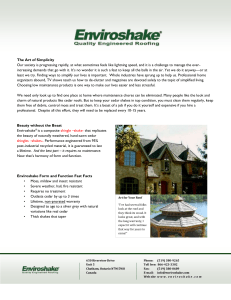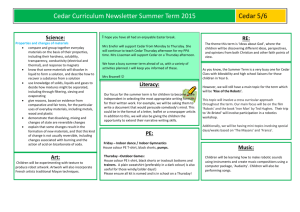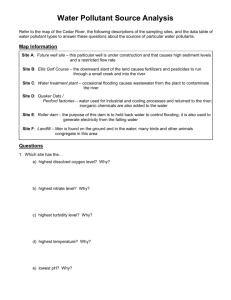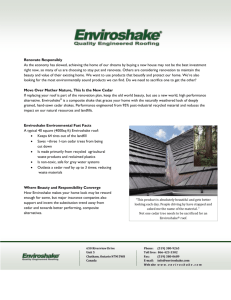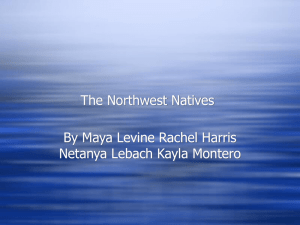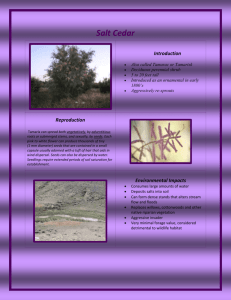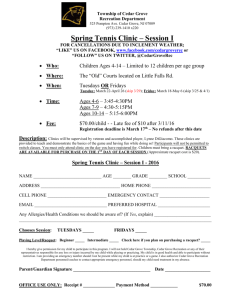LESSON- Commensalism, Parasitism, & Mutualism
advertisement
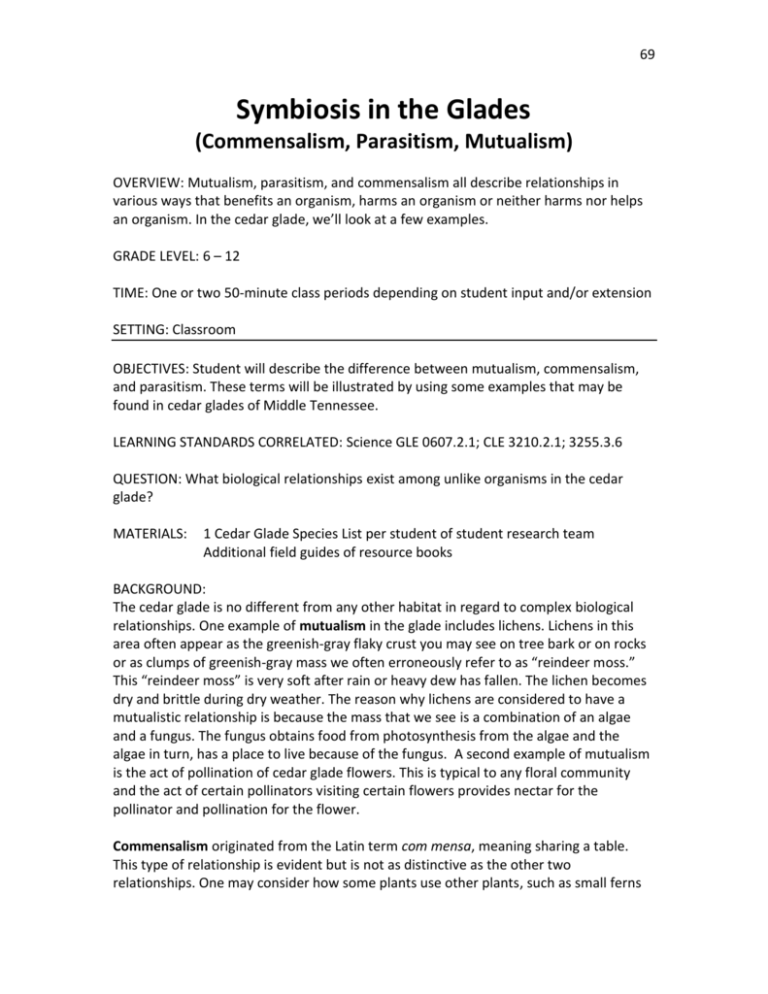
69 Symbiosis in the Glades (Commensalism, Parasitism, Mutualism) OVERVIEW: Mutualism, parasitism, and commensalism all describe relationships in various ways that benefits an organism, harms an organism or neither harms nor helps an organism. In the cedar glade, we’ll look at a few examples. GRADE LEVEL: 6 – 12 TIME: One or two 50-minute class periods depending on student input and/or extension SETTING: Classroom OBJECTIVES: Student will describe the difference between mutualism, commensalism, and parasitism. These terms will be illustrated by using some examples that may be found in cedar glades of Middle Tennessee. LEARNING STANDARDS CORRELATED: Science GLE 0607.2.1; CLE 3210.2.1; 3255.3.6 QUESTION: What biological relationships exist among unlike organisms in the cedar glade? MATERIALS: 1 Cedar Glade Species List per student of student research team Additional field guides of resource books BACKGROUND: The cedar glade is no different from any other habitat in regard to complex biological relationships. One example of mutualism in the glade includes lichens. Lichens in this area often appear as the greenish-gray flaky crust you may see on tree bark or on rocks or as clumps of greenish-gray mass we often erroneously refer to as “reindeer moss.” This “reindeer moss” is very soft after rain or heavy dew has fallen. The lichen becomes dry and brittle during dry weather. The reason why lichens are considered to have a mutualistic relationship is because the mass that we see is a combination of an algae and a fungus. The fungus obtains food from photosynthesis from the algae and the algae in turn, has a place to live because of the fungus. A second example of mutualism is the act of pollination of cedar glade flowers. This is typical to any floral community and the act of certain pollinators visiting certain flowers provides nectar for the pollinator and pollination for the flower. Commensalism originated from the Latin term com mensa, meaning sharing a table. This type of relationship is evident but is not as distinctive as the other two relationships. One may consider how some plants use other plants, such as small ferns 70 benefiting from trees. Ferns often grow on the edges of the cedar glade zone where soil is deeper and moist but also benefit from the shade of the cedar-hickory woods. Another example may include the scattered winged elm trees or cedar trees having a hole made by a woodpecker of years past. This hole is vacated after these birds finish nesting. In turn, the holes can be used for other smaller birds that are cavity nesters, such as the Carolina Chickadee (Poecile caroliniensis) and Tufted Titmouse (Baelophus bicolor). Both of these birds are agile but lack the means to make their own cavity, therefore must rely on others to do the initial work before gaining the benefit. Parasitism is common to many organisms living in the cedar glade. Two examples quite common to the red cedar tree (Juniperus virginiana) is the bagworm (Thyridopteryx chemeraeformis) and the other is cedar apple rust (Gymnosporangium juniperiviginianae). The bagworm is a caterpillar that interweaves materials such as twigs and leaves with silk. The adult female remains in the bag she made as a larva while the adult male is moth-like and sooty black in color. Bagworms overwinter as eggs inside the female bag and eggs hatch in late spring. The larvae begin to feed on the cedar leaves until late summer, then loop strands of silk around a twig to become attached. They change positions to rest with their heads pointing to the grounds. They remain in this pupal stage for four weeks. In early fall, the males leave their cases, fly to the bags of the female and mating takes place. The female deposits a mass of eggs on the cedar tree (500-1000) and she crawls out of the bag, drops to the ground and dies. The damage from bagworms can be extensive. A fungus causes the cedar apple rust. It first appears as woody, round galls (½ - 2” wide) with brown projections called “telia” in early spring. During wet weather, the telia absorb water, swell, and become orange and fleshy. At this stage, spores are emitted and this causes plants of the rose family, such as apples, to develop rust spots. The disease passes from junipers to apples back to junipers. The cedar tree acts as an alternate host and suffers slight harm, while the fungus causes severe damage to the primary rose family hosts. It usually is of interest and fascination to most who have ever witnessed this “weird orange finger-like” ball on a nearby cedar tree for the first time. A third example of the many ways parasitism may occur in a typical cedar glade is exhibited in the bird, the Prairie Warbler (Dendroica discolor). This yellow-breasted bird with black streaks on its sides is frequent in the cedar glades, and often seeks the one scrubby tree or bush in the cedar glade on which to perch and/or nest. Its song is very distinctive and easy to learn if a newcomer visits the glades in spring. The song trills up the scale with its “zzee-zzee-zzee-zzee-zzee-zzee-zzee” and usually the bird is open view for one to see. Unfortunately, this warbler is a frequent host to the parasitic behavior of the brown-headed cowbird. The cowbird is a brood parasite, which means it lays its eggs in the nests of other birds. Birds are often unaware and assume all eggs are theirs and treat them as such. Most often the cowbird young hatch first and are larger and more aggressive than the host’s eggs and hatchlings. This often leads to the host’s young being ignored by the mother or father bird when feeding or getting pushed out of the 71 nest by the cowbird. The Prairie Warbler suffers this loss like many other warblers and other songbirds. INSTRUCTIONS: 1. Distribute a copy of the Cedar Glade Species List to students or student teams. 2. Students will choose five unfamiliar symbiotic relationships. 3. Students will research the five relationships and create a table to compare each interaction. Things to be included: (a) the habitat of each – where do they live in the glades; (b) the role they play in the cedar glades; (c) description of each – size, color; (d) unique trivia or interesting information about organism or interaction. 4. To determine other relationships their symbiotic choices may have, student groups will share information with each other. 5. Students will write a newspaper story about a selected interaction, including an interesting headline and other details from student research. Some examples: cowbird searching for a host prairie warbler feeding a baby cowbird chickadee finding a nesting cavity female bagworm cedar apple rust and nearby apple tree JOURNALING: Observe a cedar tree with a bagworm on it in spring. Keep a journal with descriptions of anything you note every few days throughout the summer through autumn. Date each entry and make general notes on the weather. 72
